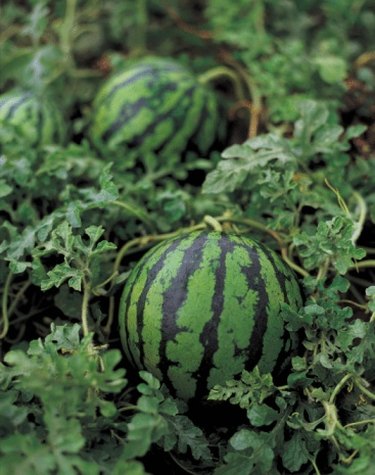Summer barbecues and camping trips would not be the same without ripe, juicy watermelons. Watermelon's revered position as a summer fruit justifies any panic or devastation that may ensue after finding rotting rinds in the melon patch. Known as end blossom rot, watermelon rotting is likely due to calcium and other nutrient deficiencies, and too much or irregular watering. If you've experienced end blossom rot, the likelihood of saying goodbye to rotted watermelons this year is great. However, if you take several steps next year, it will ensure a successful crop.

Video of the Day
Things You'll Need
Compost
Nets (Optional)
Scissors
Nylon (Optional)
Biodegradable Plastic Mulch Sheeting
Garden Lime
Soil Test Kit
Step 1
Test the soil for nutrient deficiencies or pH imbalance using a soil test kit. Find soil test kits at garden centers or request one from your regional university extension office.
Video of the Day
Step 2
Correct the soil in accordance with the test results in the fall or winter before the next growing season. Watermelon prefers a pH between 6.0 and 7.0. If the pH is too low, add the recommended amount of garden lime. Lime will add calcium. If the pH is too high, mix up to 25 percent compost into the soil. Compost will help sandy soils to retain moisture and nutrients better and will add nutrients like nitrogen and potassium.
Step 3
Line the ground of the watermelon patch just before planting with biodegradable black plastic mulch sheeting. The sheeting will help prevent rot by keeping the melons from touching the wet soil for prolonged periods of time. Cut out 3-inch diameter holes where the watermelons will be planted. Space watermelon seeds at least 12 inches apart to prevent rot due to close cultivation. Another option is to suspend growing melons from a fence or trellis using nets or nylon.
Step 4
Water watermelons with a regimented routine, such as twice a week with the sprinkler, except during rainy periods. Watermelons need approximately 1 inch of water a week. Do not allow the soil to remain soggy for long periods but don't let it dry out either.